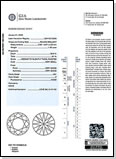Ron is a local client who called us on a Thursday night to say he was about ready to buy a diamond ring at a jewelry store but that some of his buddies told him to call us since they had purchased their diamond rings from us. Ron said he wanted to propose on Saturday so getting a ring quick was real important.
 We asked what kind of diamond was in the ring and he said it was an ideal cut GIA certified diamond. We offered that if he wanted to fax us a copy of the certification we would be happy to evaluate it for him and tell him if he was getting a good diamond for a reasonable price. He said he had not seen the certification but would call the jewelry store and get that information. A few minutes later he called back and said when he asked about the certification, the jeweler told him it was actually an EGL certification. Ron had asked the jeweler to fax it to him and then he faxed a copy to us to examine and explain.
We asked what kind of diamond was in the ring and he said it was an ideal cut GIA certified diamond. We offered that if he wanted to fax us a copy of the certification we would be happy to evaluate it for him and tell him if he was getting a good diamond for a reasonable price. He said he had not seen the certification but would call the jewelry store and get that information. A few minutes later he called back and said when he asked about the certification, the jeweler told him it was actually an EGL certification. Ron had asked the jeweler to fax it to him and then he faxed a copy to us to examine and explain.
The diamond turned out to be a 0.91 carat round diamond with G color and SI1 clarity on the EGL certification (not GIA). The interesting specifications were the cut parameters. The certification said the diamond had a 64.5% depth percentage. Strangely, the crown height percentage was listed as 15% and the pavilion depth percentage as 66%. Keep in mind the crown percentage plus the pavilion depth percentage plus the girdle percentage is suppose to add up to the total depth percentage or at least very close to it. This diamond had a problem in that it was cut too deep but just as troubling was the fact that the certification had an error on it.
Remember, the jeweler said the diamond was ideal cut. While definitions vary as to what constitutes ideal cut, the greatest depth percentage we would consider to be ideal would be 62.9%. More importantly, diamonds that are cut very deep like the one at the jewelry store are much smaller in size (millimeter diameter) than they should be for their carat weight. Ron was looking for a diamond that looked close to a one carat. Keep in mind a well cut one carat should measure 6.3-6.5 mm in diameter. Instead, the jewelry store’s diamond measured 6.0 mm; the size of a 0.82 carat even though it weighed 0.91 carat in weight.
We passed this information on to Ron and gave him the price of a GIA certified diamond with better color and the same size that we could sell for hundreds of dollars less. We also said that it was our experience that most gals would rather have a bigger and better diamond even if it meant waiting a few extra days to get it.
Ron said he appreciated all our help and advice but that Saturday was her birthday and he really wanted to propose on her birthday so was going to get the jewelry store ring. We suspect some or all of the following might have happened; 1) the jeweler would not sell him the mounting unless he bought the EGL diamond he offered, 2) the jeweler through in something extra like “life-time warranty”, 3) Ron felt that giving the ring on his girlfriend’s birthday was more important than getting the best diamond. We never did hear from Ron again.
Lessons to be learned:
- Get at least a copy of the certification for any diamond you are considering purchasing.
- If the jeweler says it is a GIA certified diamond, be sure you are shown a GIA certification. It has become all too common for jewelry stores to throw around the term “GIA certified” for diamonds that are not.
- Since it is the cut of the diamond that produces the beauty, do not settle for a round diamond that has cut parameters outside the ideal or premium cut ranges.
- Do not get fixated on a proposal date if it means making a poor decision on your diamond purchase. The special gal who is going to wear the diamond for many years deserves the best diamond not something just because it is quick.
